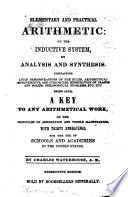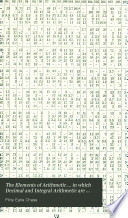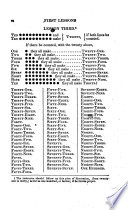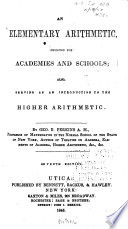 | George Hutton (arithmetic master, King's coll. sch.) - 1844 - 276 pages
...= 3, the common difference; and the whole series 3 : 6 : 9 : 12 : 15: 18 : 21: 24. Hence the RULE. Divide the difference of the extremes by the number...and the quotient will be the " common difference, or ratio of the progression. EXAMPLES FOR PRACTICE. 1. The first term of an arithmetical progression... | |
 | Nathan Daboll - Arithmetic - 1844 - 254 pages
...first term, the last term, and the number of terms given, to find the common difference. ROLE. — Divide the difference of the extremes by the number of terms less 1 . and the (lnotirn* will he the common diffetonoe. i EXAMPLES. 1. The extremes are 3 and 29, and the number of... | |
 | Charles WATERHOUSE - Arithmetic - 1844 - 228 pages
...last term, and number of terms, to find tiie common difference ; or sum of all the terms. RULE. — Divide the difference of the extremes by the number of terms less 1, the quotient will be the difference. Multiply the sum of the extremes by the number of terms, and half... | |
 | Pliny Earle Chase - 1844 - 258 pages
...the difference of the extremes 24, must be 8 times the common difference, which is therefore 3. RULE. Divide the difference of the extremes by the number of terms less one, and the quotient will be the common difference. This difference repeatedly added to the less,... | |
 | Pliny Earle Chase - Arithmetic - 1844 - 246 pages
...the difference of the extremes 24, must be 8 times the common difference, which is therefore 3. RULE. Divide the difference of the extremes by the number of terms less one, and the quotient will be the common difference. This difference repeatedly added to the less,... | |
 | Horatio Nelson Robinson - Arithmetic - 1845 - 310 pages
...of the extreme terms, or mean term, by the number of terms. RULE 3. To find the common difference. Divide the difference of the extremes by the number of terms less one. RULE 4. To find the number of terms. Divide the difference of the extreme terms by the common... | |
 | Arithmetic - 1845 - 210 pages
...for a farthing ? Ans. 86 L. 17 S. 10 d. CASE 2. When the two extremes and number of terms arc RULE. Divide the difference of the extremes by the number of terms, less one ; the quotient will be the common difference. EXAMPLES. 1. Twenty and sixty are the two extremes... | |
 | Arithmetic - 1846 - 258 pages
...term, the last term, and the number of terms be ing given, to find the common difference. RULE. — (') Divide the difference of the extremes by the number...1, and the quotient will be the common difference. liiieslinn. — 1. How do you find the common difference? EXAMPLES. 1. The extremes are 2 and 53, and... | |
 | Almon Ticknor - Arithmetic - 1846 - 274 pages
...first term, the last term, and the number of terms being given, to find the common difference. RULE I. Divide the difference of the extremes by the number...1, and the quotient will be the common difference sought. 1. The extremes are 3 and 39, and the number of terms is 19 ; what is the common dfference... | |
 | George Roberts Perkins - Arithmetic - 1846 - 266 pages
...term, the last term, and the number of terms, to find the common difference, we have this • RULE. Divide the difference of the extremes by the number of terms, less one,. EXAMPLES. 1. The first term of an arithmetical progression's 5, the last term is 176, and the... | |
| |